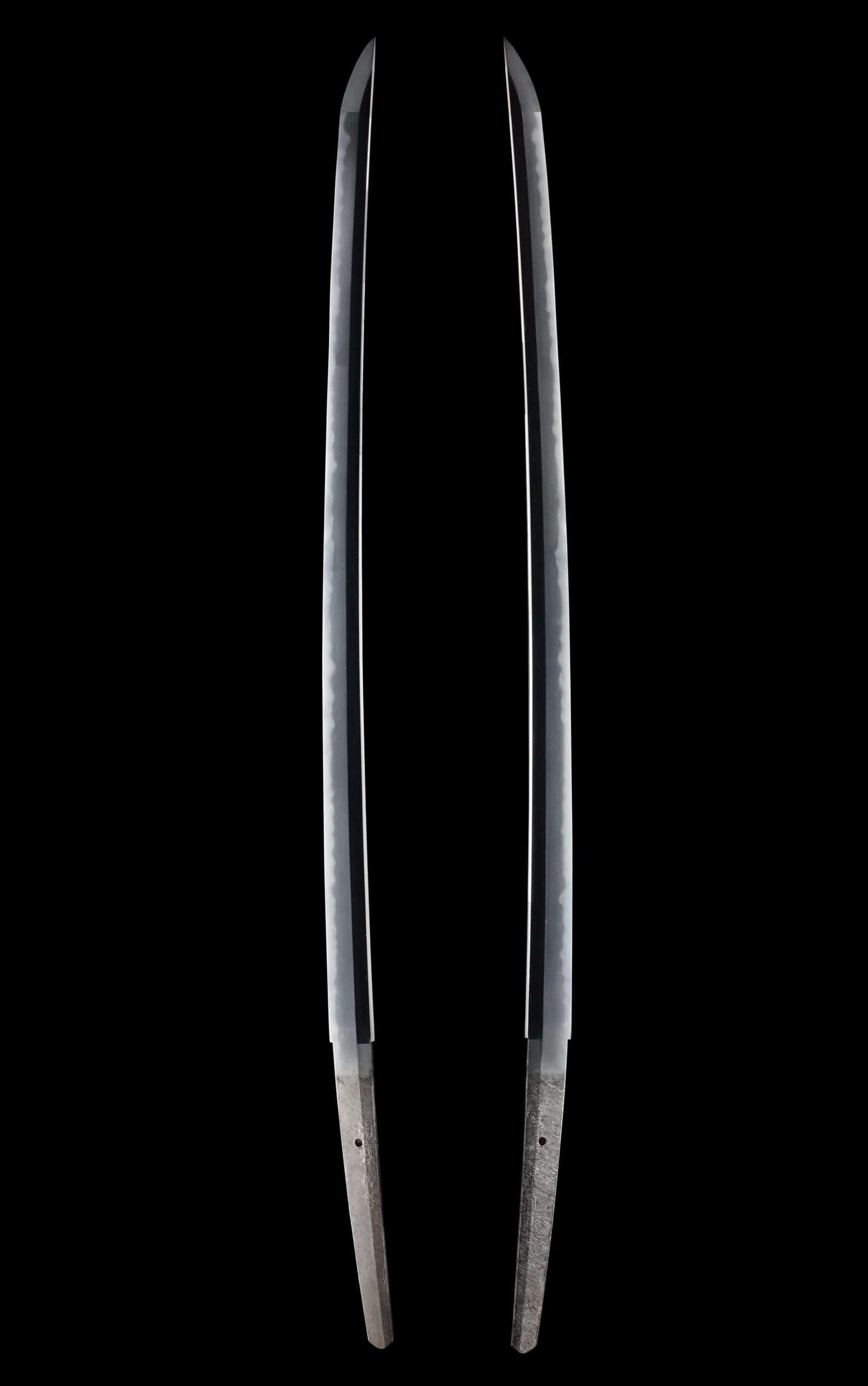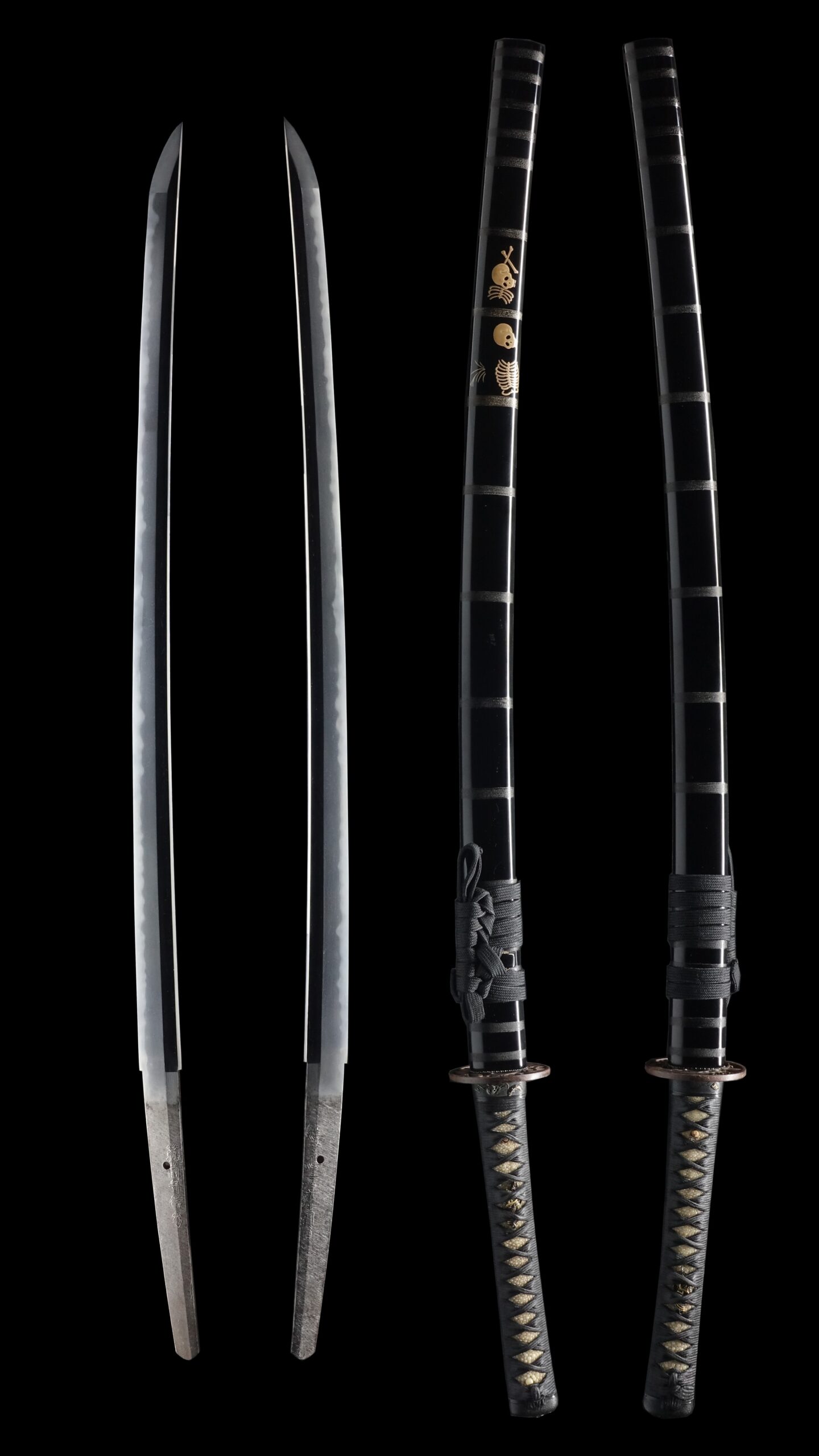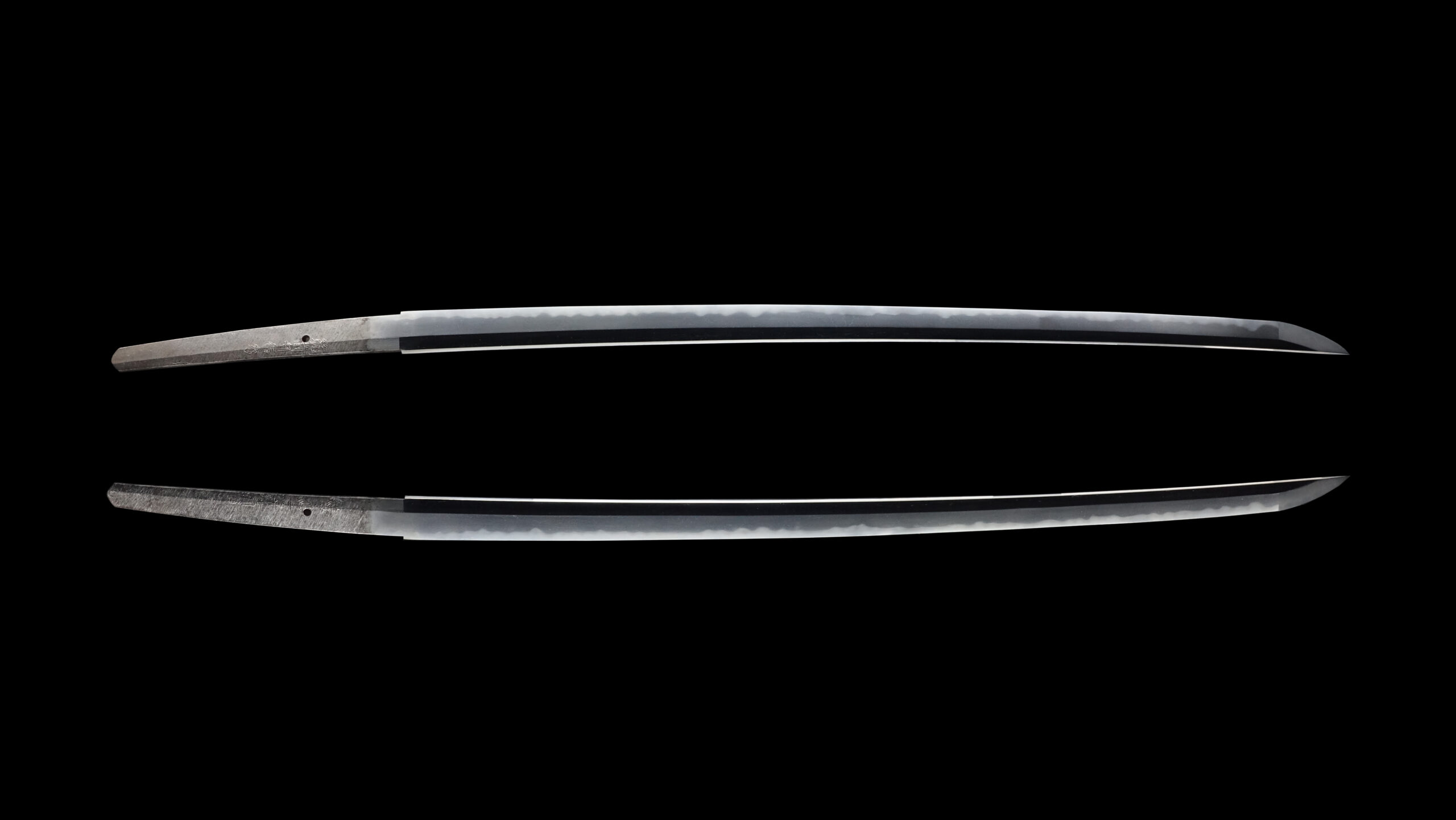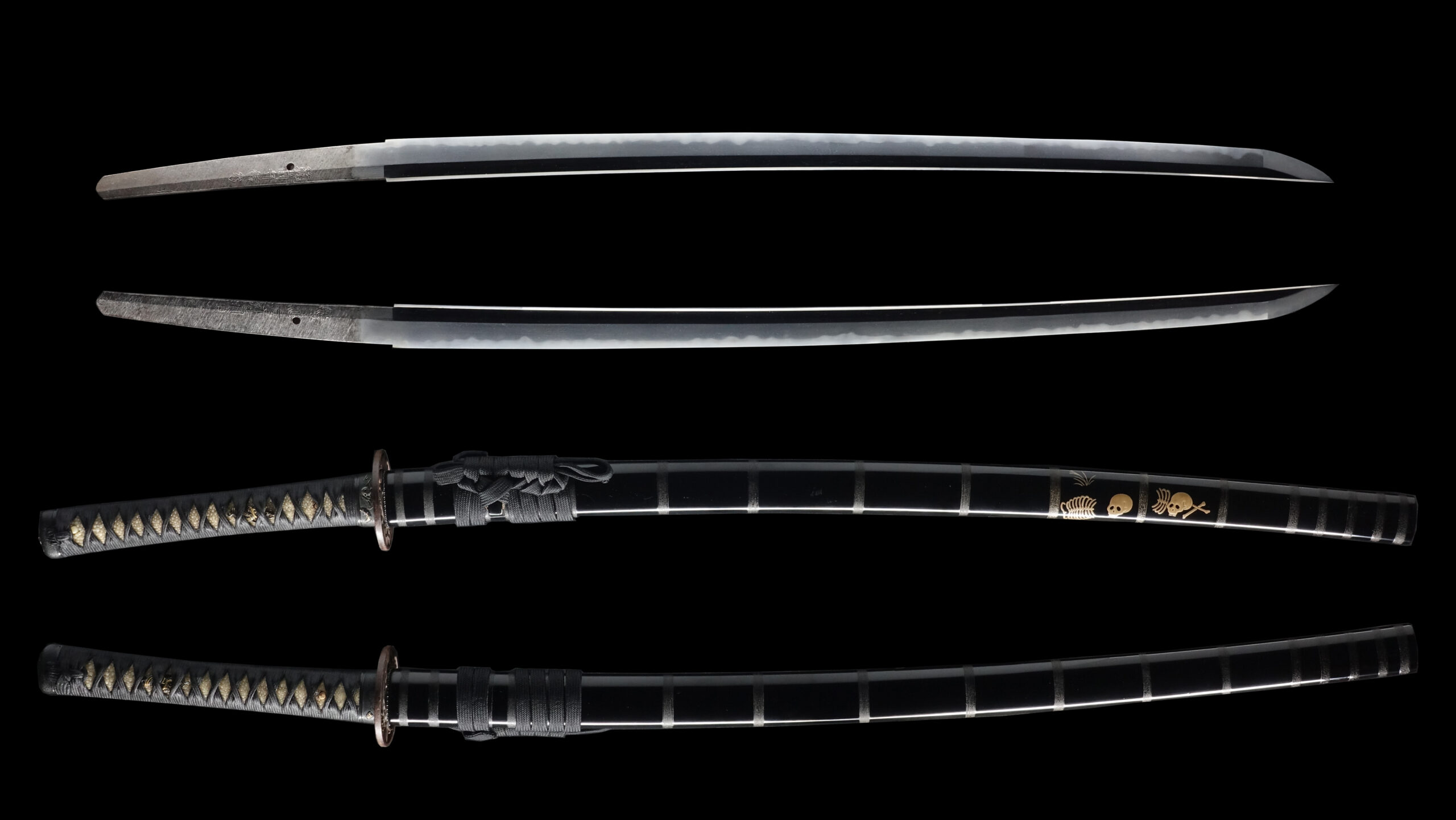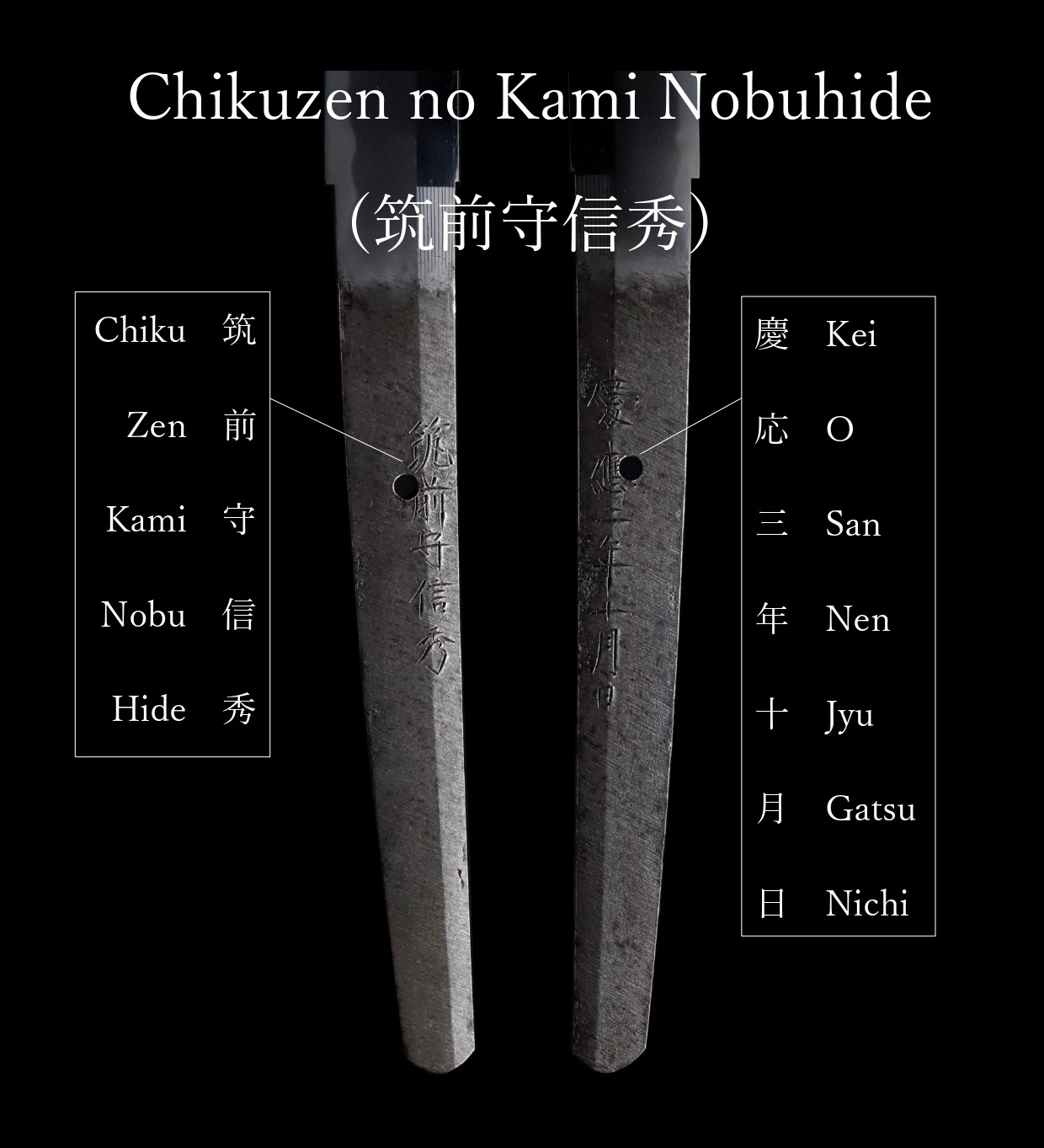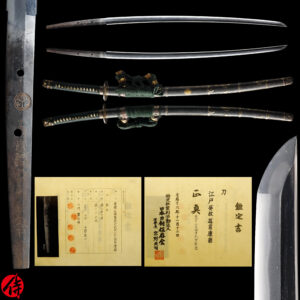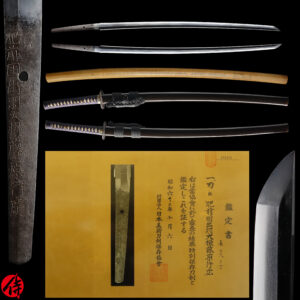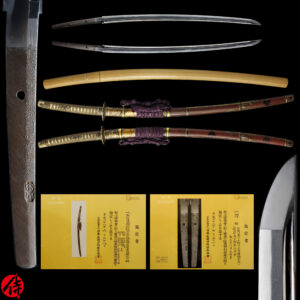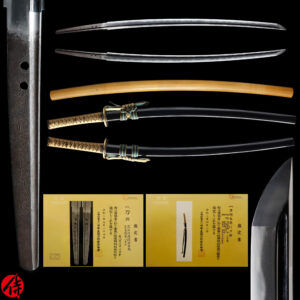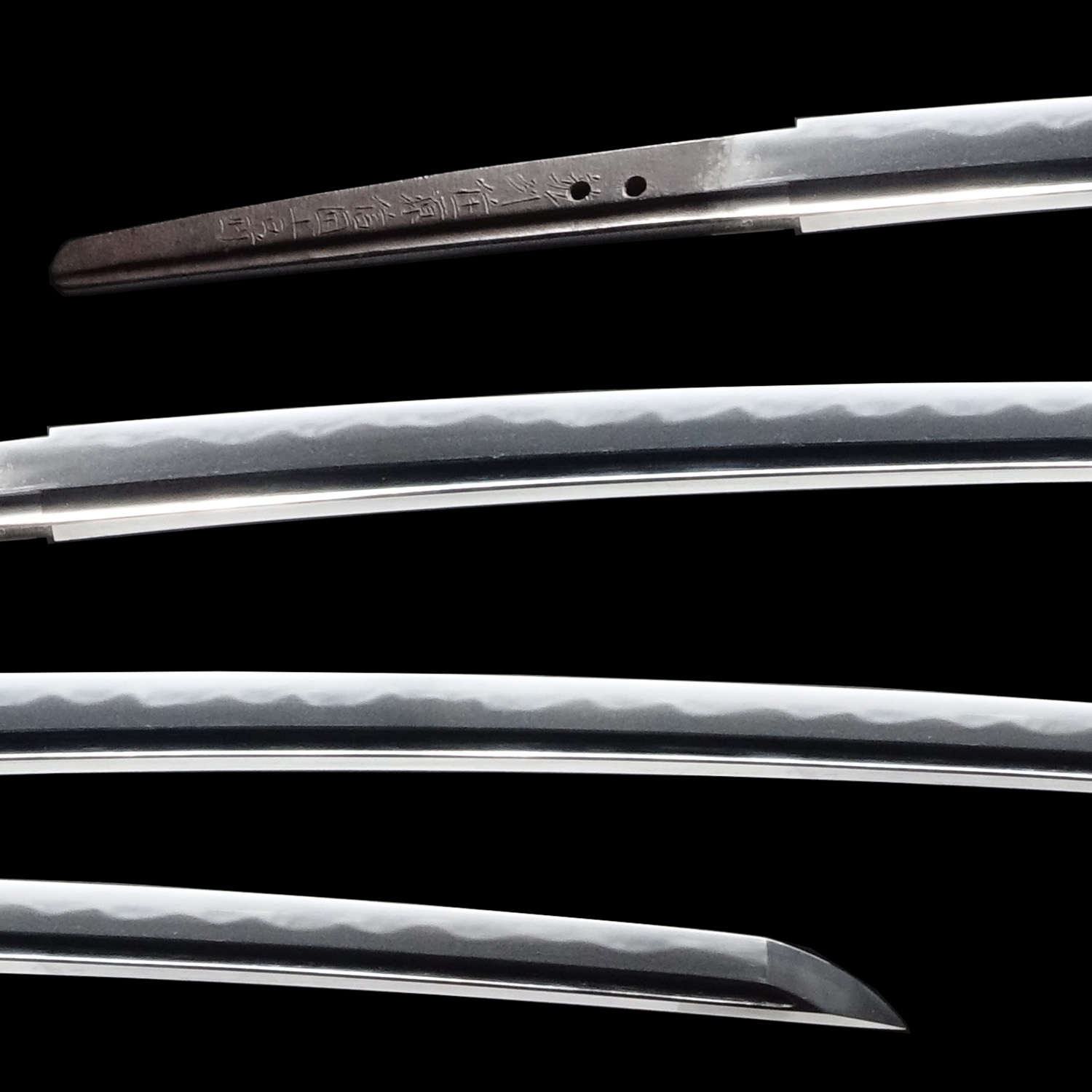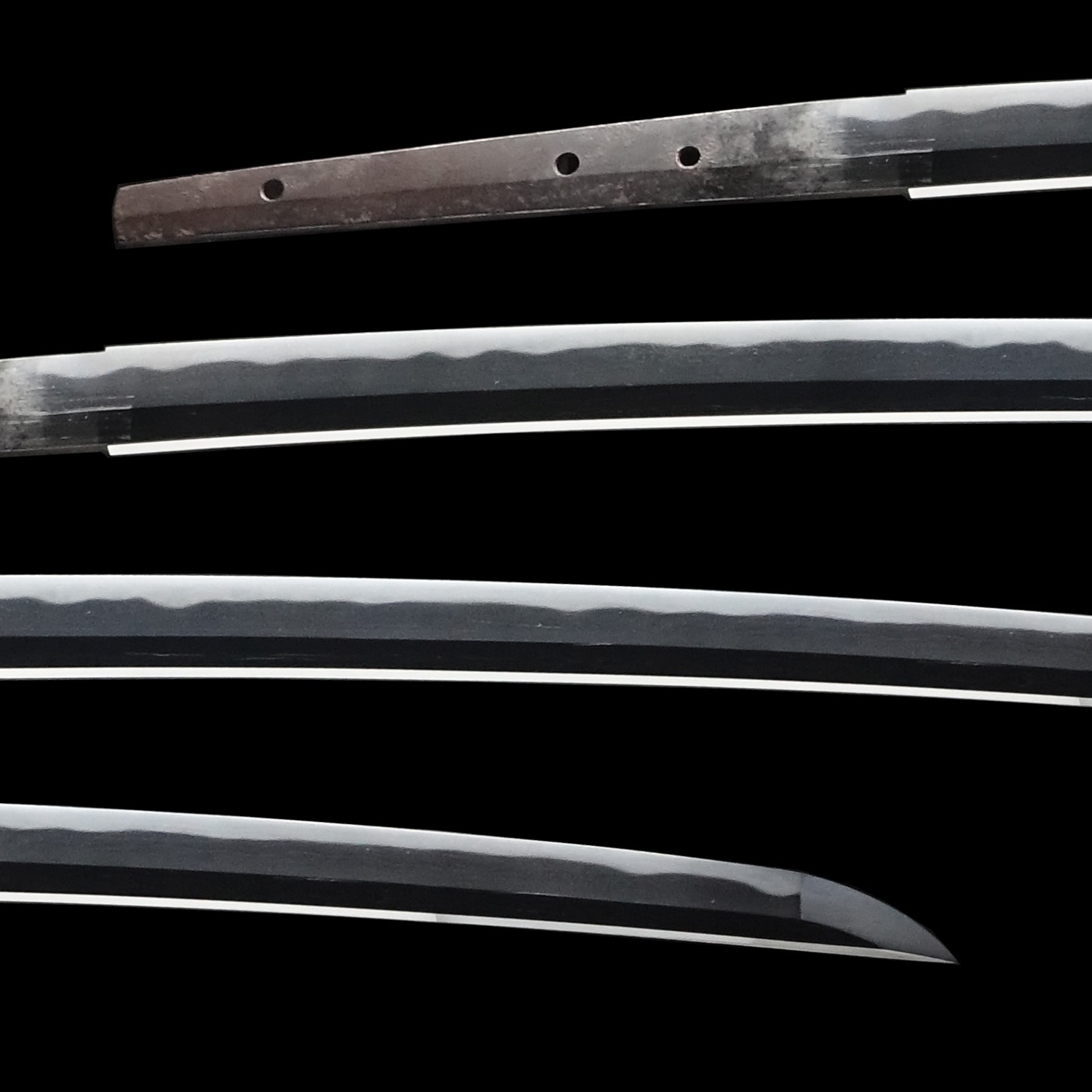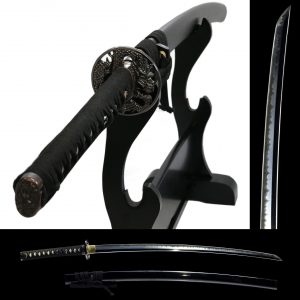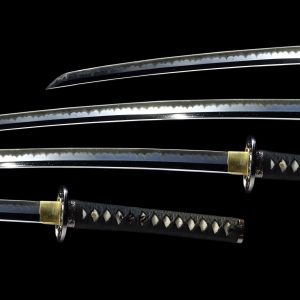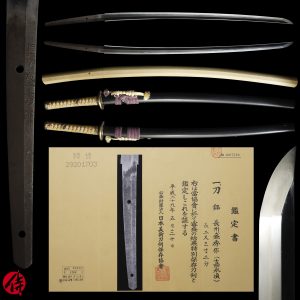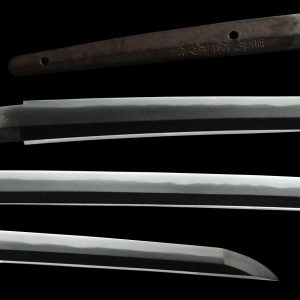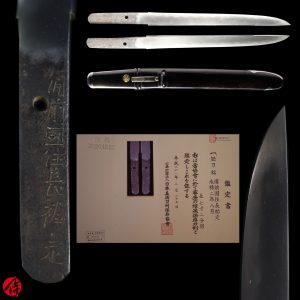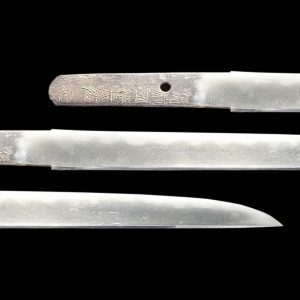Antique Japanese Sword Katana Signed by Nobuhide with Tokubetsu Hozon Certificate
【Description】
This blade was signed by Chikuzen no Kami Nobuhide (筑前守信秀) in the 3rd year of the Keio era (1866: The end of the Edo period). Its Koshirae’s theme is an extremely rare *Nozarashi (野晒し).
Nobuhide was born in Echigo province (today’s Nigata prefecture) in the 12th year of the Bunka era (1815).
In the 12th year of the Bunsei era (1829), he moved to Kyoto and became a famous mirror craftsman. Eventually, he relocated to Edo city (today’s Tokyo) to become an apprentice of Kiyomaro in the third year of the Ka-Ei era (1850). Nobuhide was about 34-35 years old when he first studied sword-forging techniques from Kiyamaro, one of the most skilled and renowned swordsmiths at the end of the Edo period. Kiyomaro was just two years older than Nobuhide back then.
He was so talented that he mastered superb craftsmanship from Kiyomaro in less than three years. Nobuhide was treated as Kiyomaro’s No1 apprentice.
Nobuhide became an independent swordsmith in the fifth year of the Ka-Ei era (1852). In the first year of the Keio era (1865), he received an honorable official title Chikuzen no Kami (筑前守) from the emperor Komei. According to historical records, he stayed in Sagami province (today’s Kanagawa prefecture) during 1853-1854. And he resided in Osaka between 1864-1867. Based on this information, we believe this blade was made in Osaka.
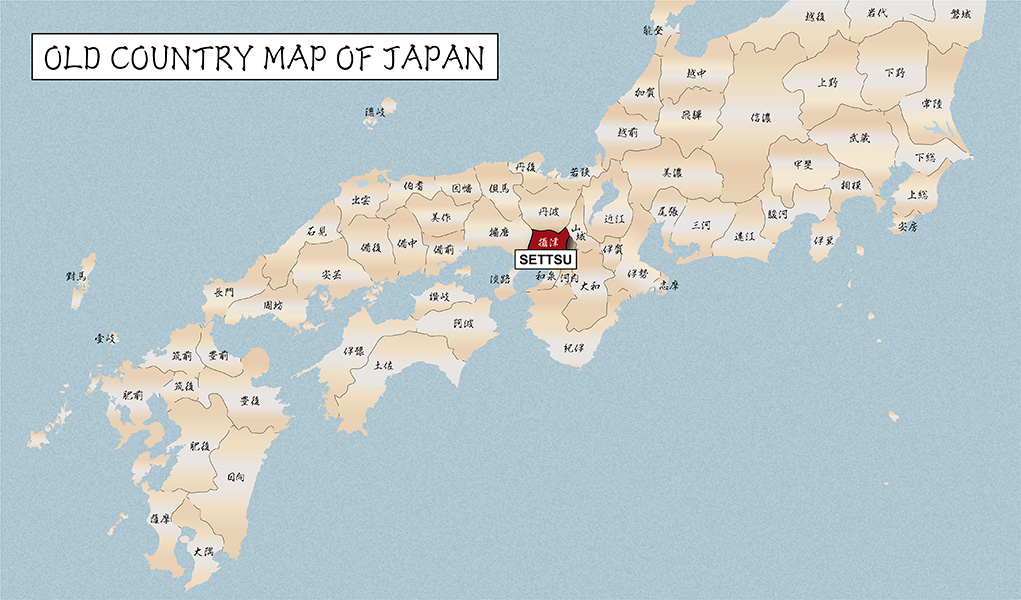
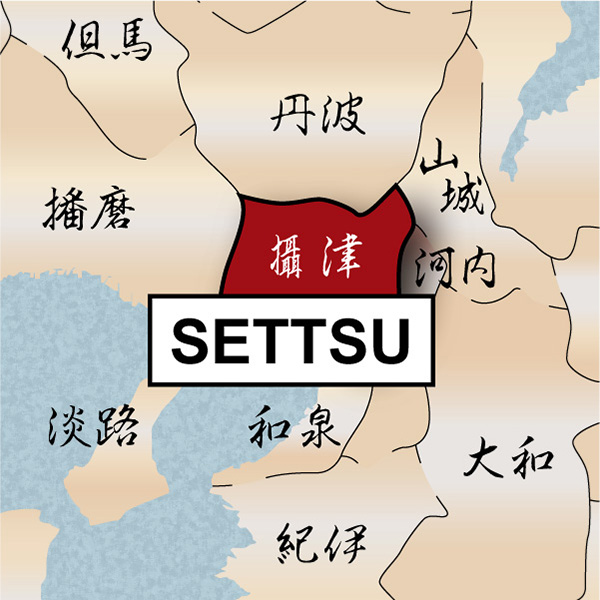
In his early career, he signed Nobuhide (信秀) and then changed it to Kurihara Kenji Nobuhide (栗原謙司信秀). And lastly, he signed Taira Nobuhide (平信秀).
Nobuhide was active between 1852-1877 (the 5th year of Ka-Ei~10th year of the Meiji era). He is known as one of the three masters of the sword-forging at the end of the Edo period. The other two are Gassan Sadakazu and Honjo Yoshitane. Nobuhide is considered one of the top-tier swordsmiths among Japanese sword experts and collectors.
Even after the Samurai era ended in 1868, Nobuhide kept forging swords. And in the second year of the Meiji era (1869: post Samurai era), he was requested by the emperor Meiji to forge a ceremonial sword, which was considered one of the highest honors for any swordsmiths.
The Meiji government also ordered him to create three divine mirrors and a holy blade for a newly built shrine called Shokonsha (today’s Yasukuni shrine).
Shokonsha was built to honor the spirits of those who died during the civil war at the end of the Edo period. This fact suggests that Nobuhide was one of Japan’s most respected and acknowledged swordsmiths. He finished this project in the 7th year of the Meiji era (1874). And,
he came back to Echigo province and restarted making mirrors for shrines. He died at the of 66 in his house in Tokyo.
We are confident you will appreciate his exceptionally high level of craftsmanship from this blade.
It is appraised as a Tokubetsu Hozon Token(特別保存刀剣) issued by NBTHK(Nihon Bijutsu Touken Hozon Kyokai:日本美術刀剣保存協会). This authentication paper was only given to authentic Japanese swords, especially well preserved and high quality with artistic value.
【 Blade】
Cutting Edge Length(Nagasa):70.5 cm ( 27.7 inches)
Curvature(Sori): 1.0 cm ( 0.39 inches)

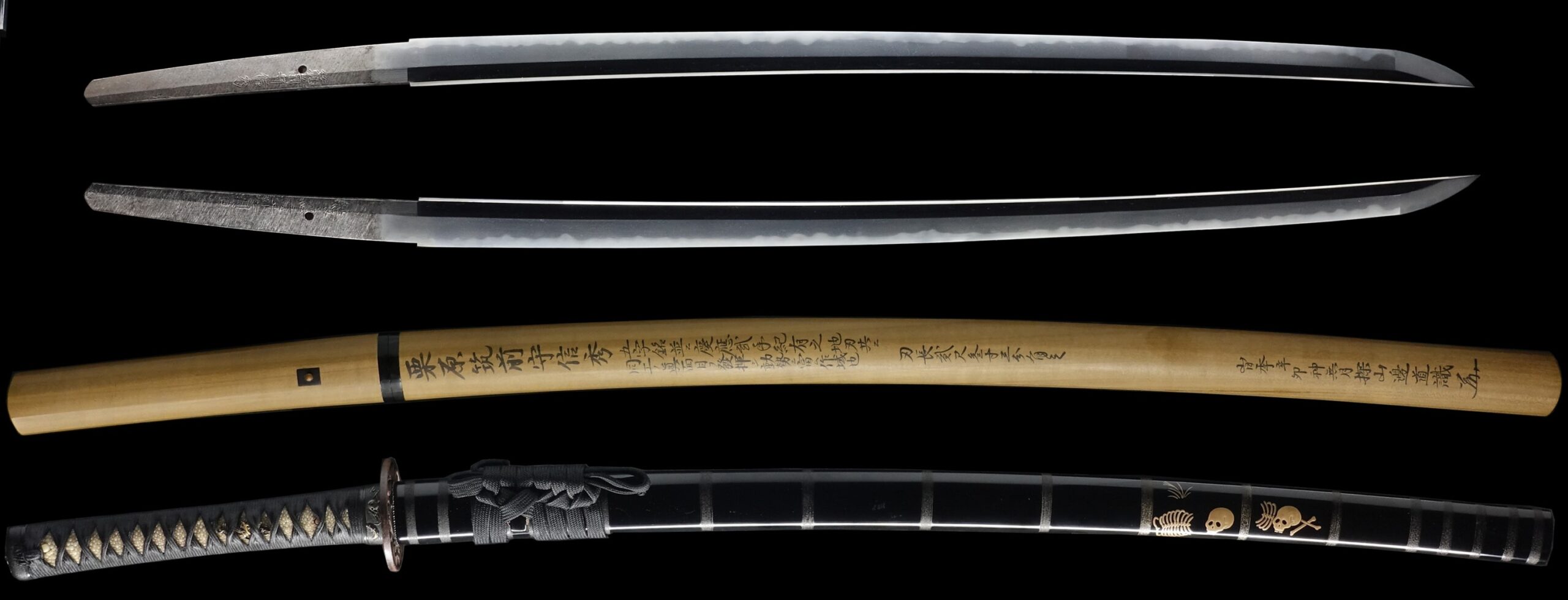
Hamon:
The crystalline structure which forms along the cutting edge of a blade as a result of the hardening process
Jimon(Jihada):
visible steel surface pattern created by folding and hammering during forging process
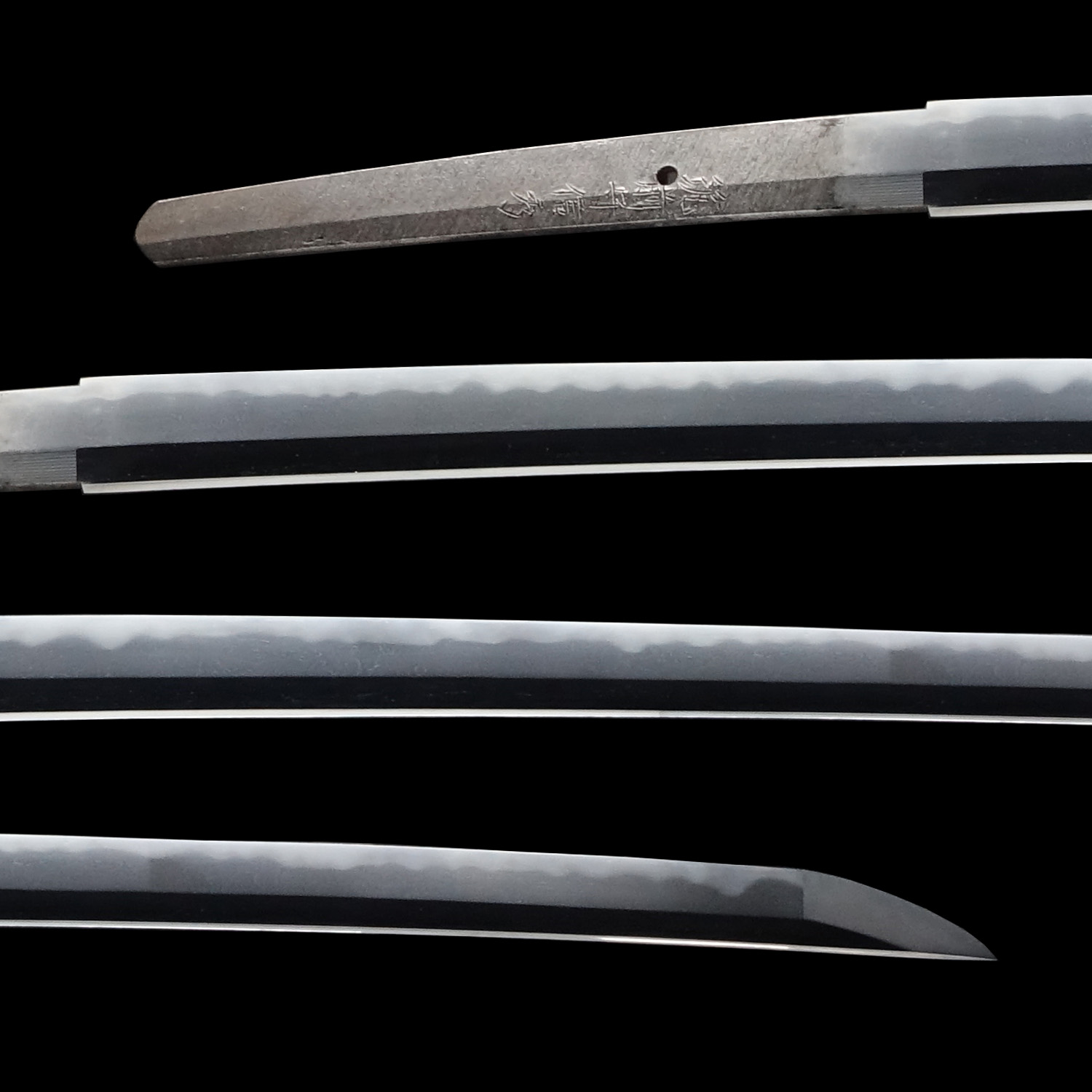

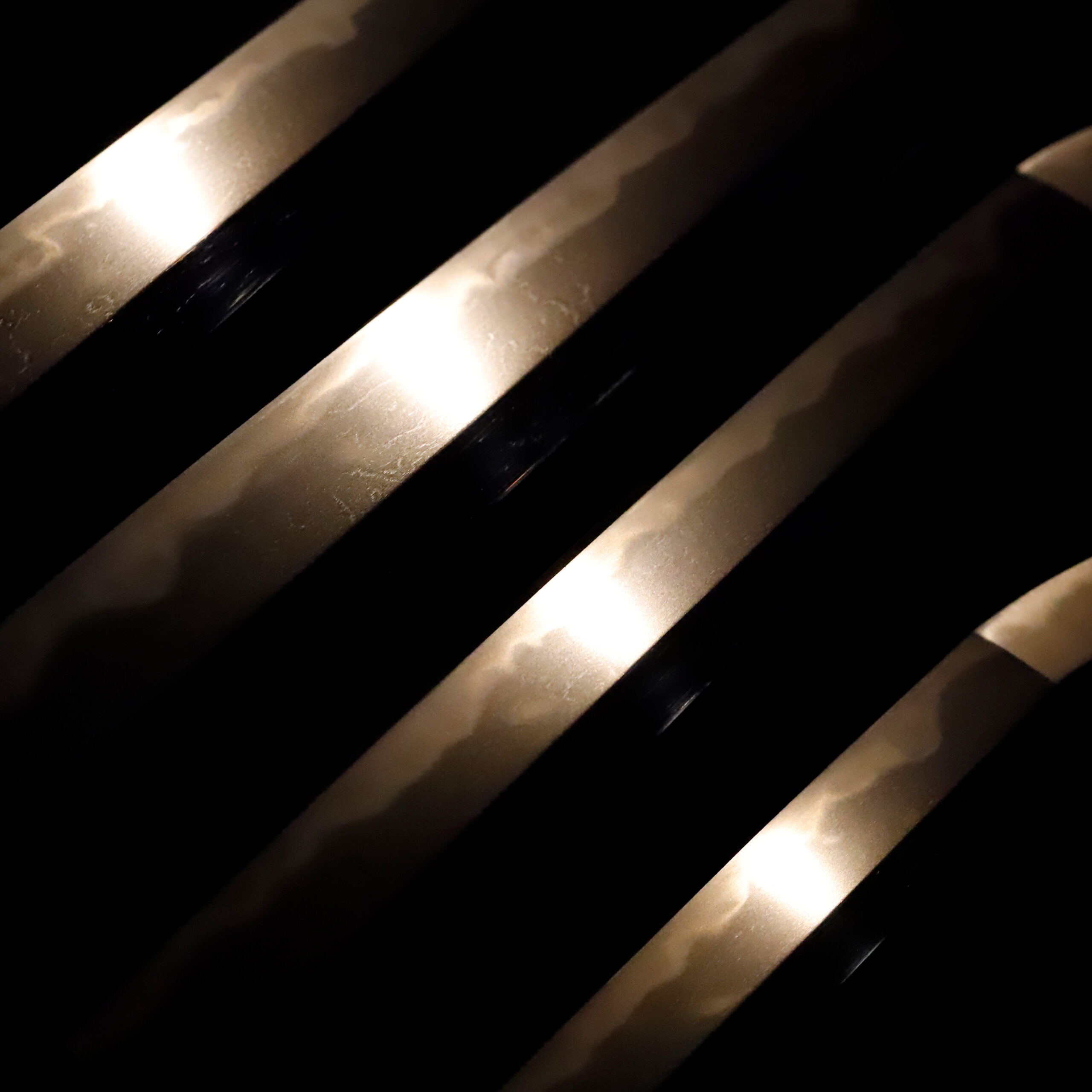
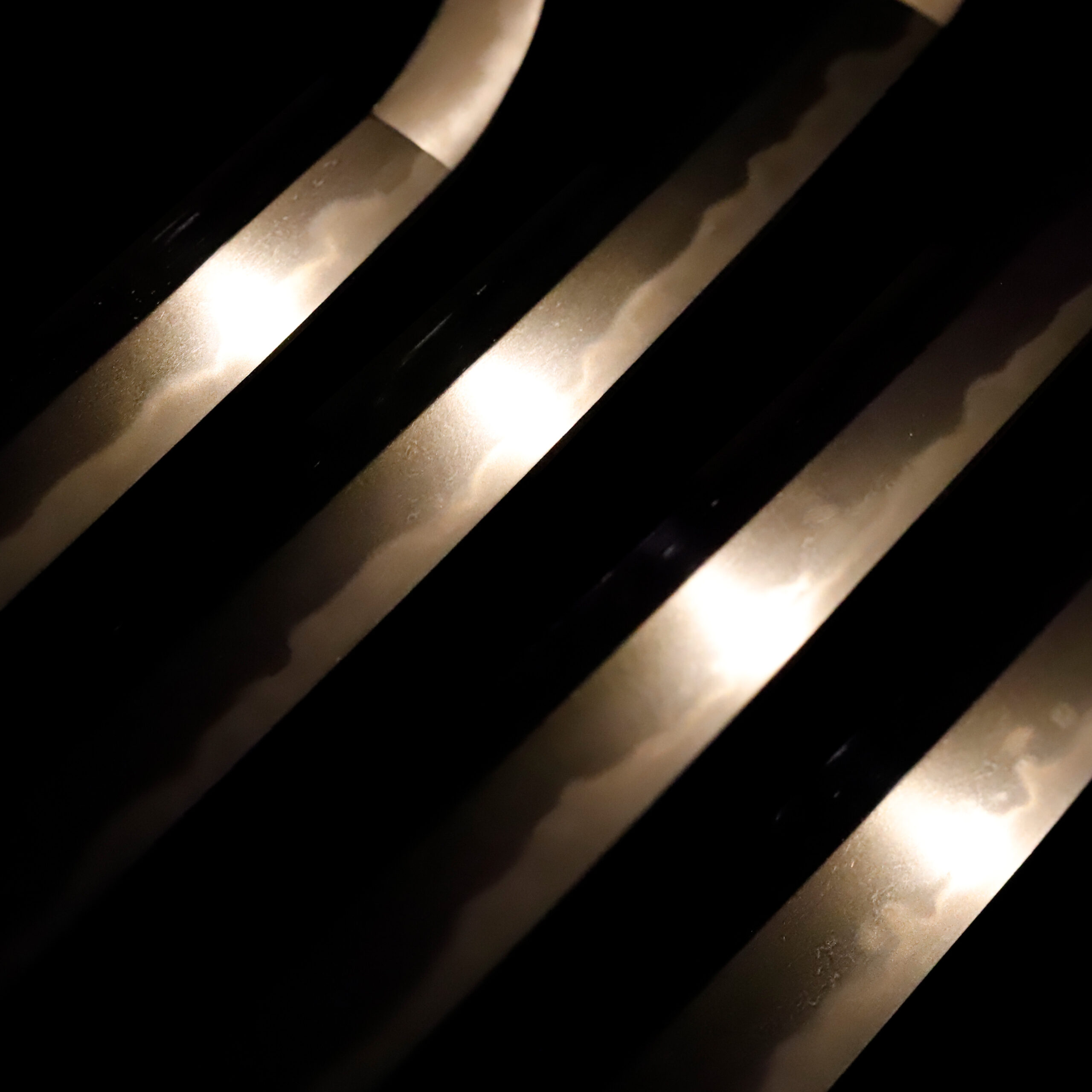
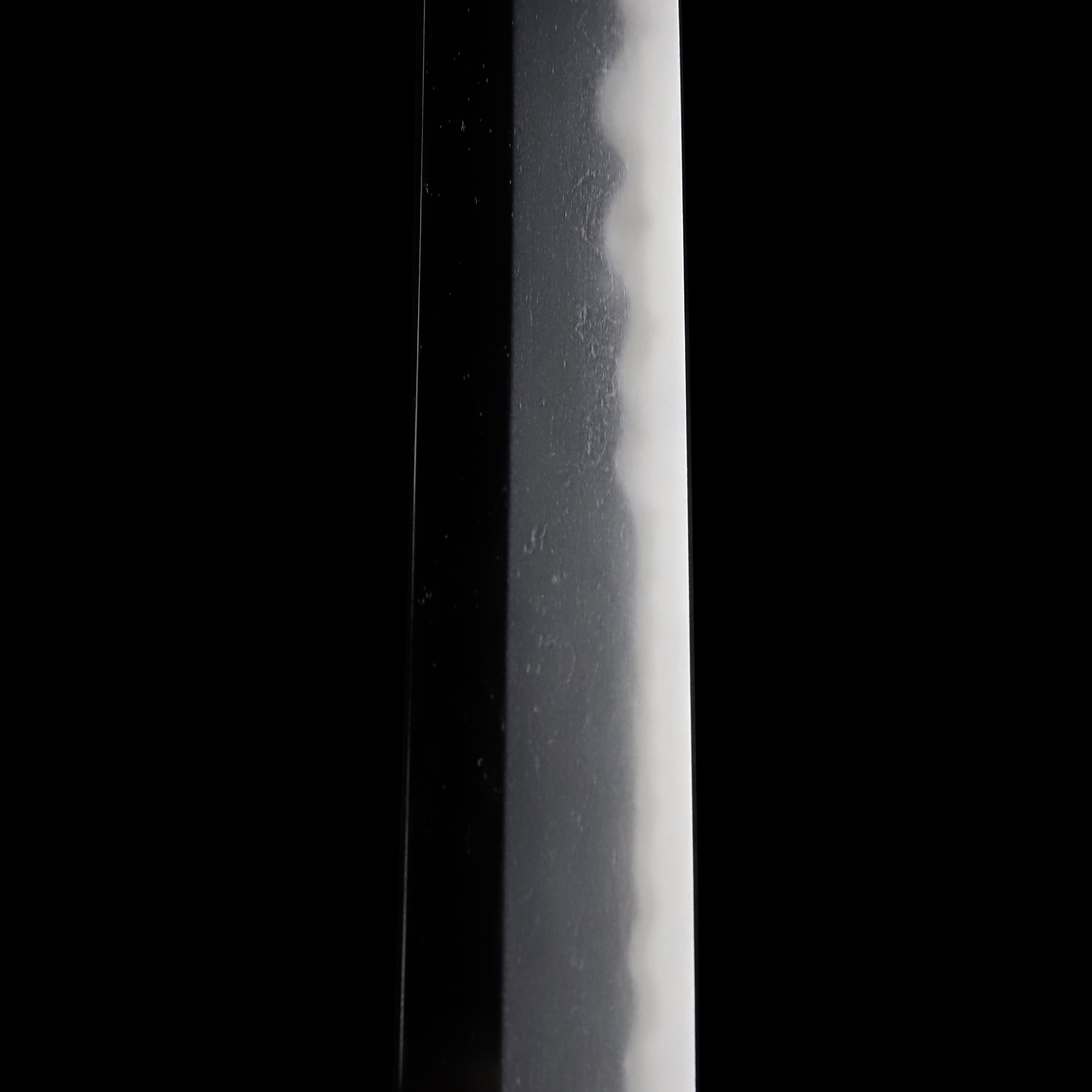
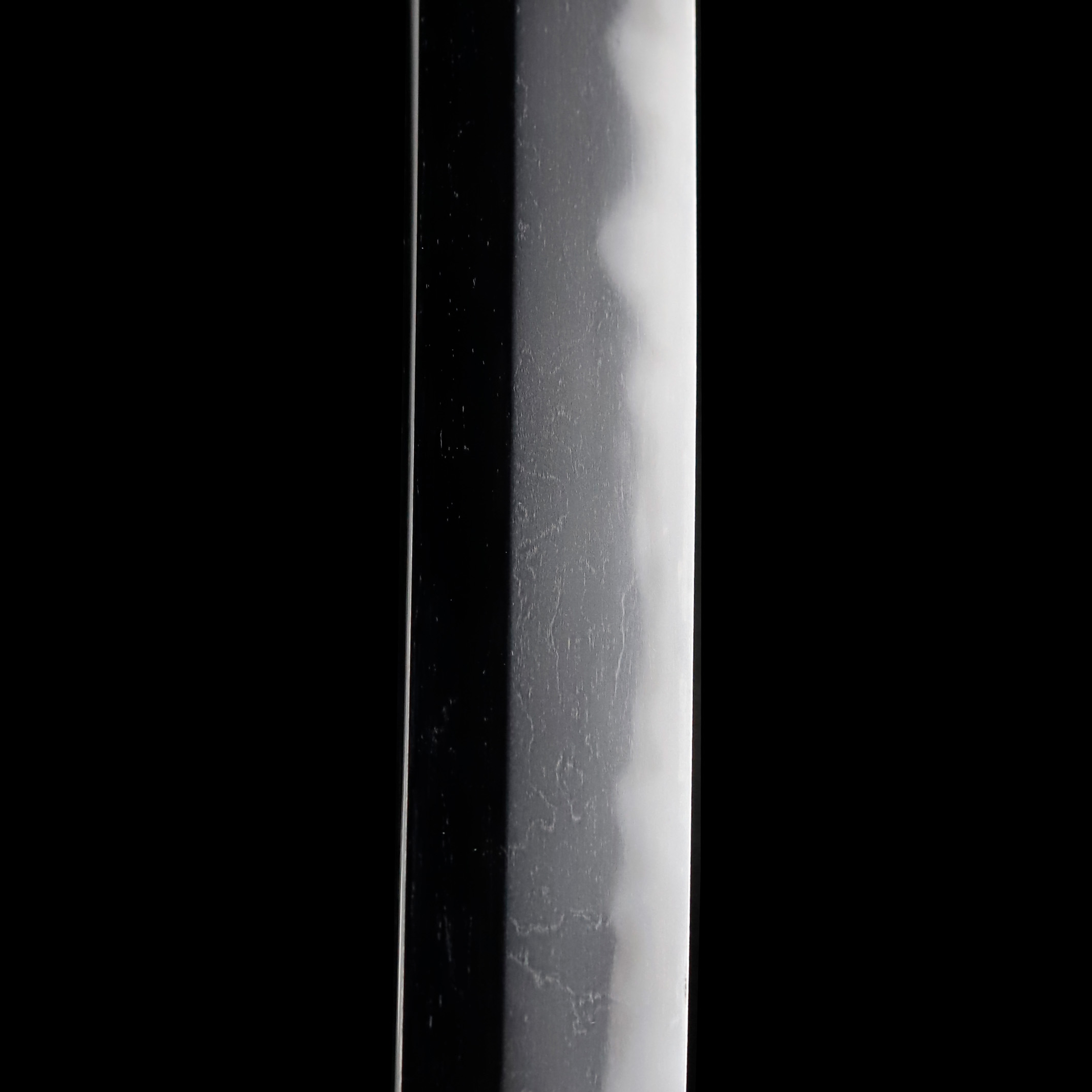
Nakago:Nakago is the tang of the Japanese sword.
Japanese swordsmiths left the black rust on the tang because it prevents red rust while the tang is in its handle. And the discoloration of the tang was created over time, and it is a great indicator for a Japanese sword specialist to estimate when the sword was forged.
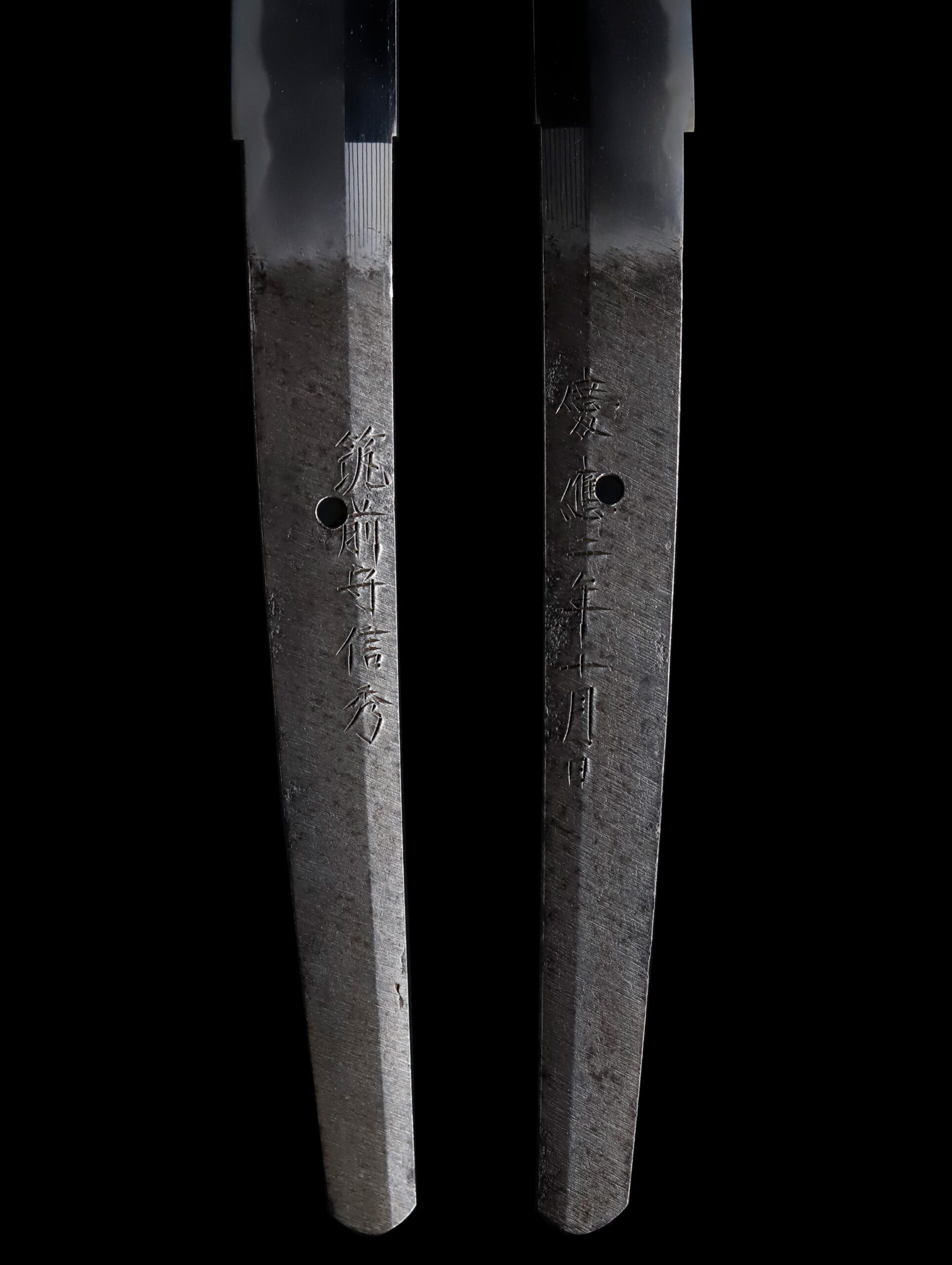
Koshirae: Nozarashi style Koshirae
Koshirae is the mounting of the Japanese sword. There are several parts that consist of Koshirae such as Saya(Scabbard), Tsuka(Handle), Tsuba(Handguard).
The entire of this sword’s Koshirae is designed with the common theme: Nozarashi-Zu (野晒図). It refers to human bones that have been exposed to winds and rain in the open air and turned into skeletons, and it often refers to skulls in particular. This Nozarashi theme has been favored since a long time ago. We could imagine that people in those days had to live in harsher conditions. In addition, Samurai warriors were always on the verge of life and death on the battlefields. We would say this theme reflects on these aspects of society at that time.
It is not just the famous warlords who left their names in history who ran through the world of warfare. Each warrior whose name was not even recorded has their own history. However, after they lost their lives, they were simply left on battlefields and returned to nature. We would say that the Nozarashi-Zu is a subject that makes us feel the transience of nameless and precious lives scattered on battlefields and the transient after wars.
If we write it like this, you might feel melancholy. However, same as other designs, we hope each viewer will enjoy their own interpretation. By incorporating this motif into the sword mountings, Samurai warriors might have roused themselves toward the battlefield or included the desire to spend time with the souls of their former comrades in arms who had already lost their lives.
At first glance, you might feel that the Nozarashi-Zu has a frightening atmosphere, but the fact is that it was incorporated as part of the decoration. And it was treated as one of the elements that boosted the aspect of Japanese swords as a work of art. We interpret that it makes us feel a sense of the high sensitivity of the people of the time. In addition, the finish of each sword mounting is excellent, and the skillful technique of the artisans could be seen everywhere. We hope you appreciate the details of the Koshirae as well as the blade.
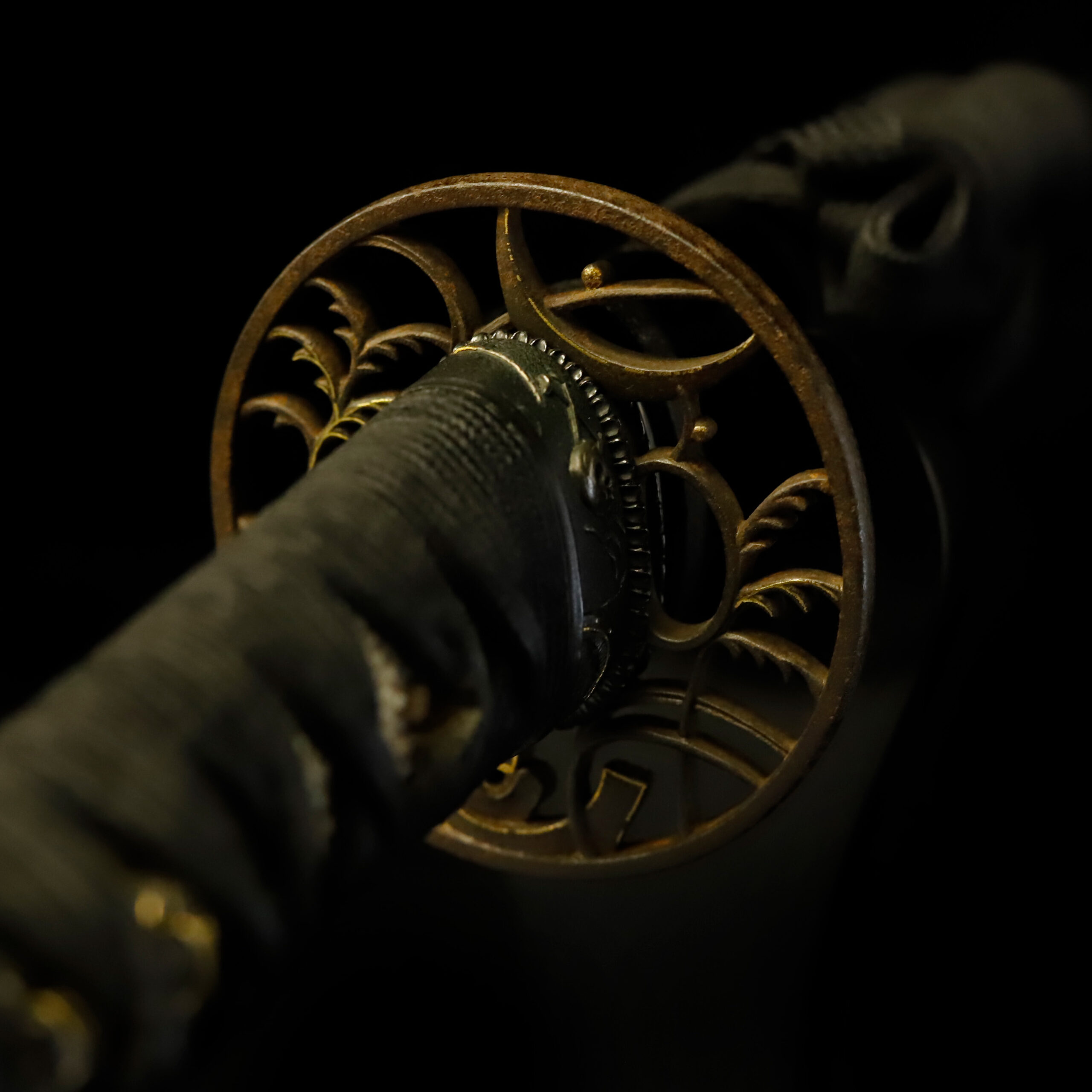
Fuchi-Kashira:A pair of matching sword fittings that cover the upper and bottom parts of its sword hilt.
This Fuchi Kashira’s design is reminiscent of the traces of war, such as skeletonized human bones, broken arrows, armor sleeves, a Samurai helmet, etcetera. Skull is generally the symbol of death, but at the same time, there is a view that skeletons represent life, immortality, revival, recovery, and eternity. The surface has a rough texture with fine irregularities like stone. Although some colorings have already faded, it seems gold and silver paints were initially applied to some parts.

Tsuka and Menuki:Tsuka is the handle of the Japanese sword and Menuki is its decoration.
The Kabuto (兜, Samurai helmet) is the motif of this Menuki. Due to its design, we judge it is a Suji Kabuto (筋兜) and has a Kuwagata (鍬形, front decoration). As several parts were colored with gold, it makes an elegant contrast with the black color of Menuki itself.
It is natural that Suji Kabuto was a popular theme for the sword mounting, considering the importance of its protection and significance as Samurai’s symbol.
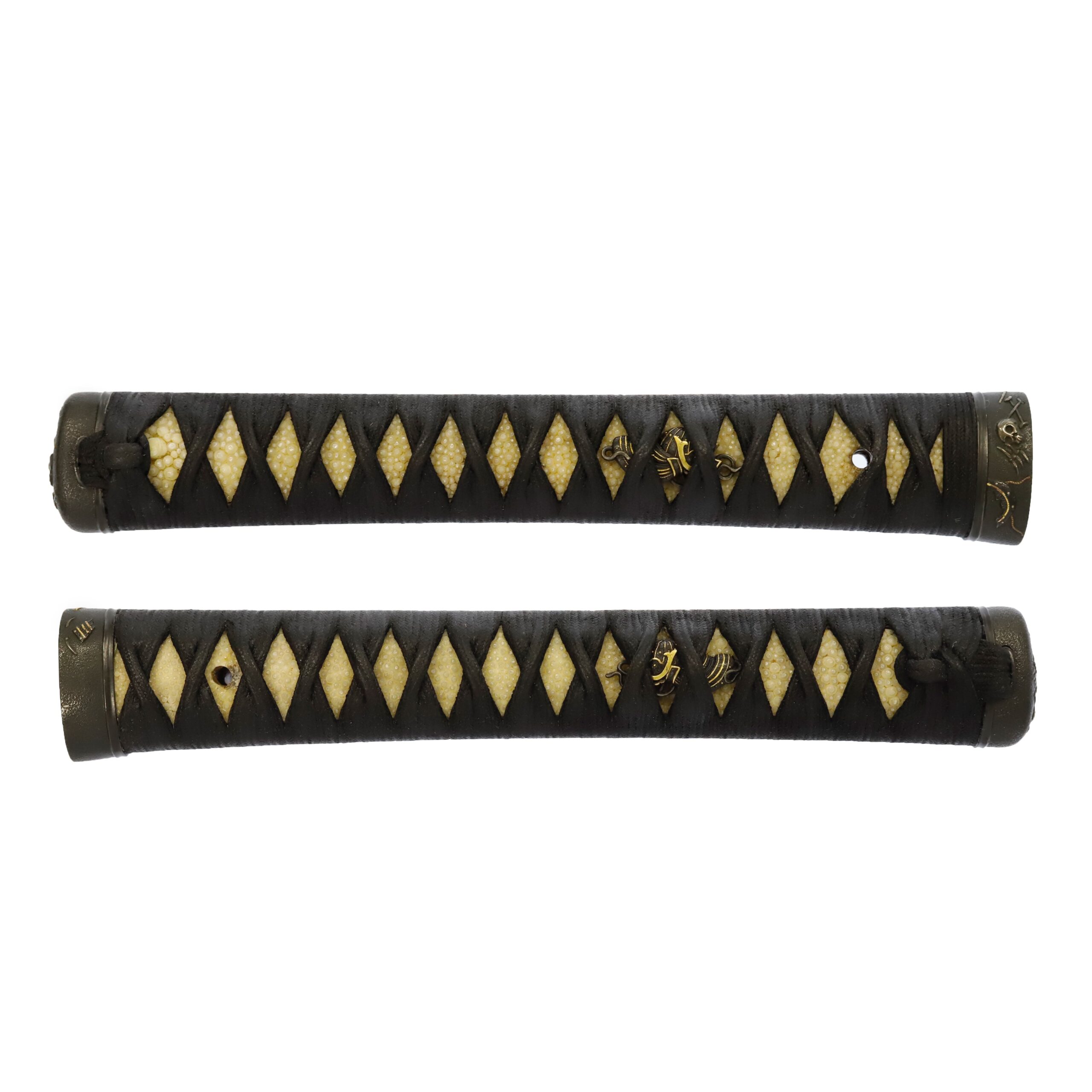
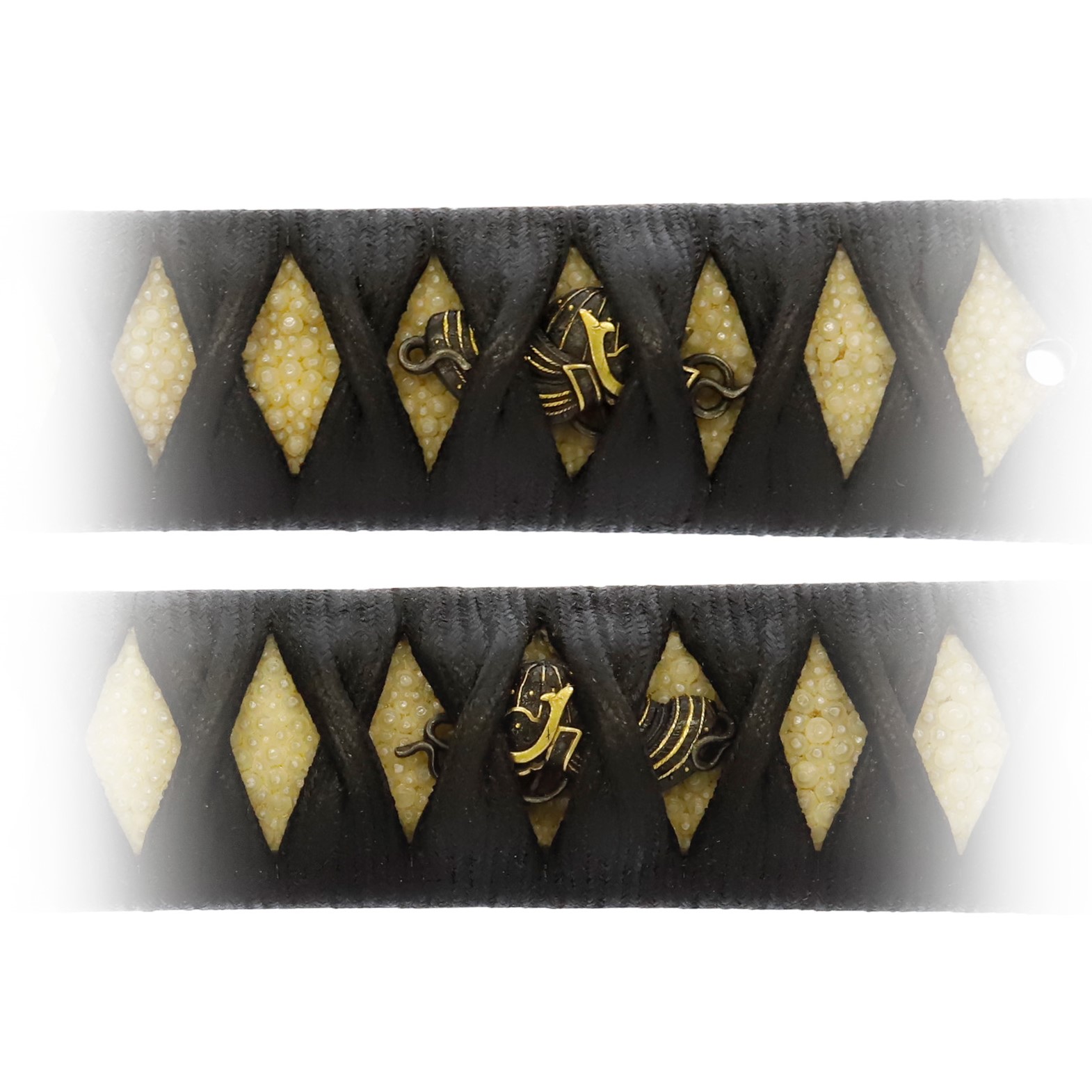
Tsuba and Habaki:Tsuba is the handguard for the Japanese Sword and Habaki is the equipment to make the blade not touch its scabbard inside. It prevents the blade from getting rusty and chipped.
Oval-shaped Tusba that has Kozuka and Kougai holes. This Tsuba depicts a scenery of a Japanese pampas grasses field. You would find an Abumi (鐙, stirrup) that is abandoned, and a crescent moon floats in the sky. It is the design that includes elements reminiscent of an autumn night, giving a sense of desolation.
The Abumi is a type of harness on which you put your feet when riding a horse. We cannot see any Samurai figure in this Tsuba. However, we could feel Samurai’s brave spirit. Even if a figure of Samurai itself is not depicted in this screen, there are certainly traces of a battle here. This Tsuba’s design indirectly portrays the battlefield.

Saya: Saya is the scabbard for the Japanese sword.
Even the design of this scabbard is a part of the Nozarashi-Zu. Skeletons and weeds are designed with golden paint on the black-lacquered scabbard. We believe this is the Makie (蒔絵) craft. It is a typical Japanese lacquer art technique developed uniquely in Japan for about 1200 years. Firstly, it needs to draw a picture with lacquer on the surface with a thin brush. Next, sprinkle the gold powder above to show the pattern before the lacquer hardens. This technique makes a gorgeous and elegant look to works, as seen in this scabbard.


Authentication Paper:NBTHK TOKUBETSU Hozon Certificate for the blade (No. 155525)
NBTHK, also known as Nihon Bijutsu Touken Hozon Kyokai (the Society for the Preservation of the Japan Art Sword), is one of the oldest Japanese sword appraising organizations in modern-day Japan. They authenticated the blade on Jan 27th in the 24th year of Heisei (2012). They appraised it as Tokubetsu Hozon Touken, the blade especially worth preserving for Japanese society. The purchaser will receive this original certificate as well. We can also translate what is written into English and make a PDF file for your record if you request.

Registration Number : Saitama 82831
The Board of Education in Saitama prefecture issued a registration paper for this sword . It is called Jyu Token Rui Torokusho(銃刀剣類登録証). Bunkacho(The Agency for Cultural Affairs) acknowledges a Japanese sword with this paper as a work of art.
The sword needs to be traditionally hand-forged and made of Tamahagane carbon steel to be registered in the system. With this paper, its owner in Japan can legally own an authentic Japanese sword. Based on this registration number, we will apply for its export permit.
This paper will need to be returned to the board of education when the sword is being shipped abroad, but you can receive a copy of it. An English translation of this registration paper is available on request.
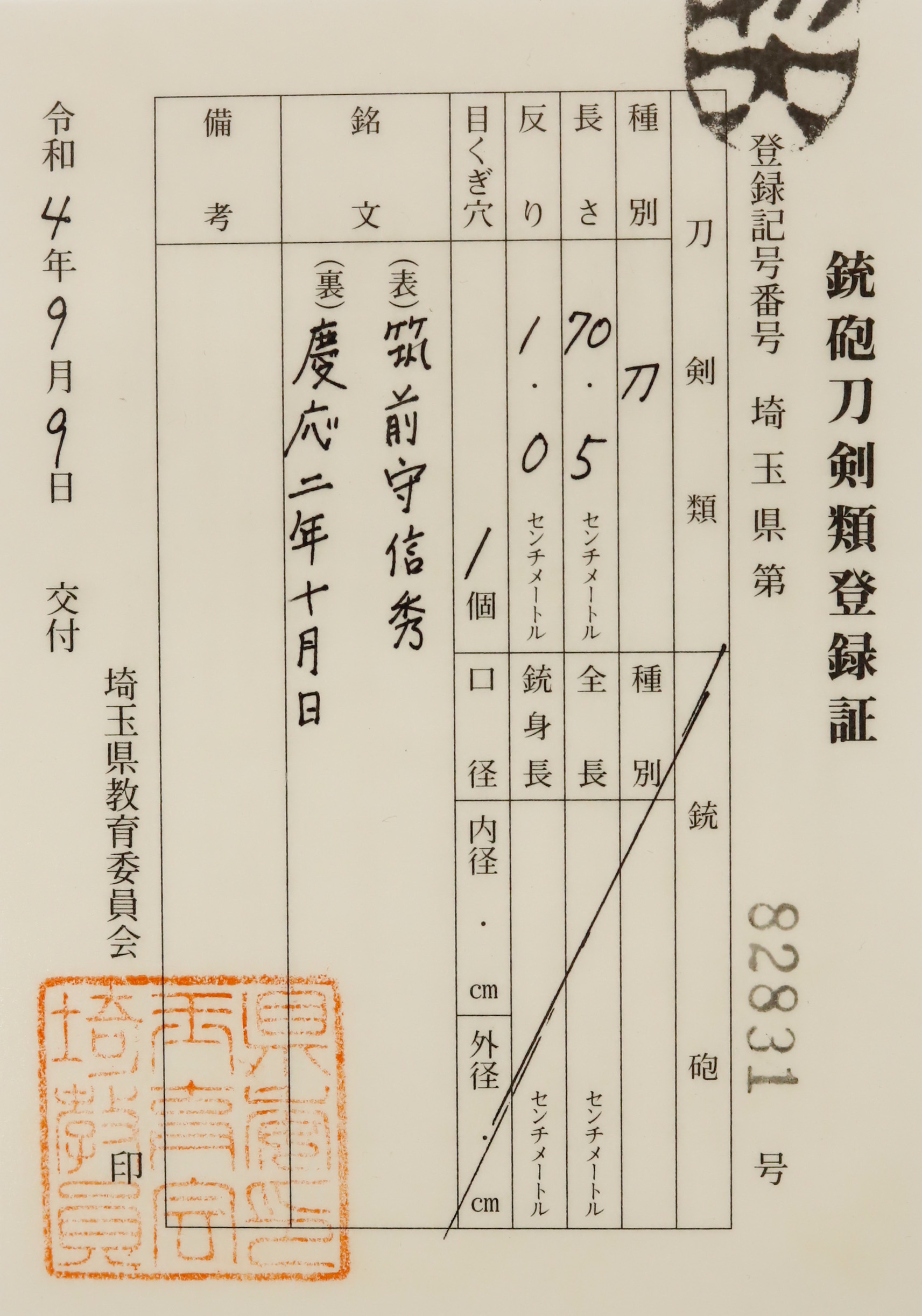
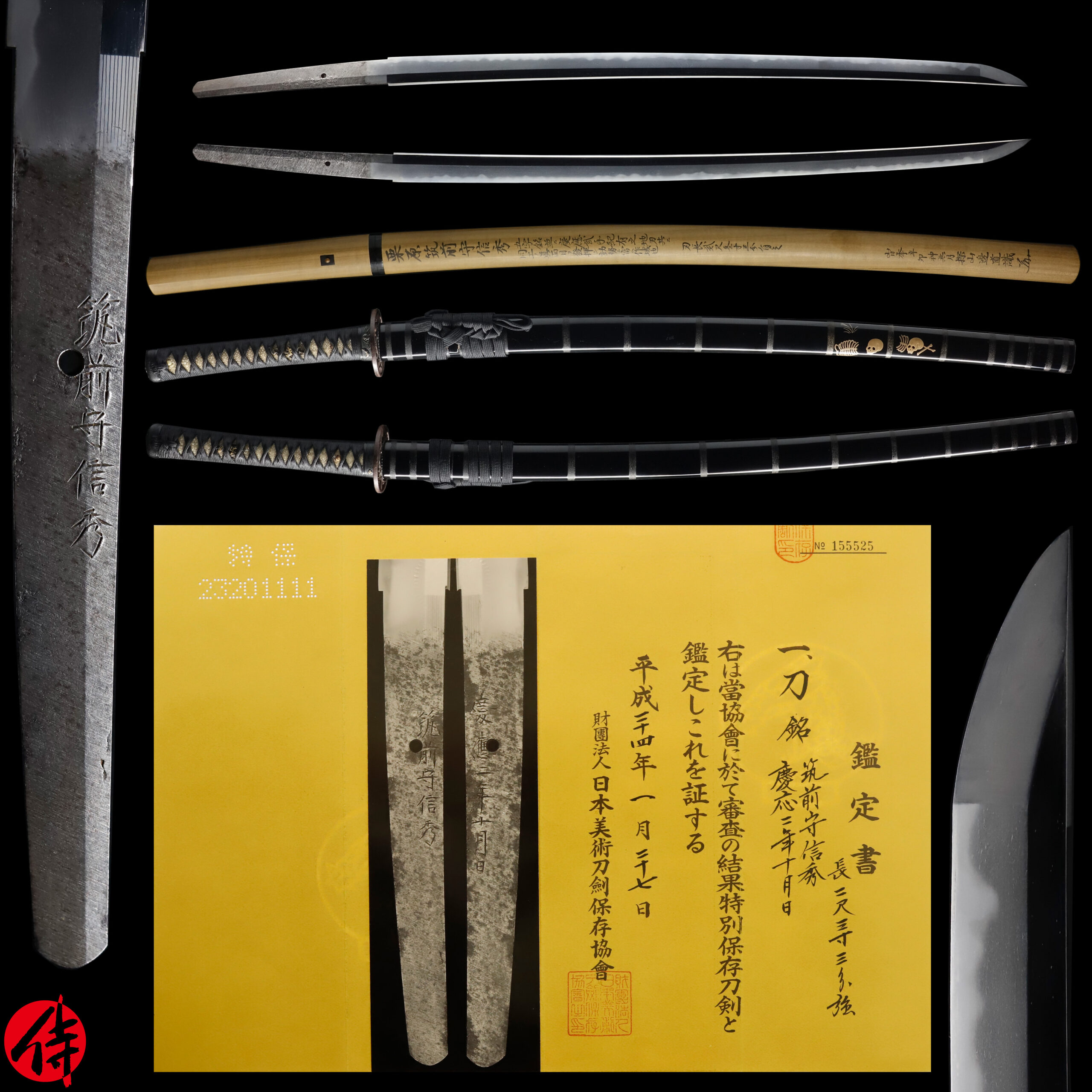
—————————————————————–
【About us】
Samurai Museum is located in Tokyo, Japan, exhibiting antique artifacts related to the Samurai history. Samurai Museum Shop is the place for those who are interested in Japanese culture and craftsmanship. We deal with antique Samurai swords/armor, traditional crafts made in Japan and so on.
【Japanese Sword& Export Process】
The Japanese swords we deal with are hand-forged edged swords made in Japan. It was made from the traditional carbon steel called TAMAHAGANE(玉鋼). Samurai Museum is familiar with the proper legal procedure for an antique/ authentic Japanese sword to be exported from Japan. We have sent more than 500 Japanese swords for the past three years (~2023) to amazing owners who appreciate its historical value.
Each Japanese sword is registered under the Agency for Cultural Affairs and the Board of Education in Japan. They issue a registration paper for each Japanese sword for its owner in Japan to legally possess it. The Japanese sword with its registration paper means it was traditionally hand-forged in Japan.
To legally export the sword from Japan to other countries, we will have to apply for its permit to the Agency for Cultural Affairs(Bunkacho) and return the original registration paper to the Board of Education. It normally takes around 2-4 weeks to receive this permit after submitting required documents. And we would like you to expect at least 1-1.5 months for your order to arrive at your given address after you ordered. For more detailed info, please click here.
It is allowed for residents in Japan to own authentic Japanese swords without a special license as long as they come with registration papers. Please feel free to contact us if you are a resident of Japan, whether temporarily or permanently. We will also assist you when you leave Japan and need to obtain the export permit.
【Payment Method】
We accept payment through Stripe (Credit card), PayPal, Apple Pay or ChromePay, all of which are secure payment methods. Also, you don’t need to make an account on Stripe for the checkout. If you prefer other payment method, please contact us. After confirming your payment, we will apply for an export permit. You may either pay in JPY, USD, AUD, CAD,EUR CHF or GBP. The price is set in Japanese Yen. Prices in other currencies are automatically calculated based on the latest exchange rate.

* If the amount is above 1 million JPY, Stripe or wire transfer will be the only options for payment.
【Shipping】
We have shipped authentic Japanese swords to the USA, UK, Canada, Mexico, Germany, France, Hong Kong and Australia. If you don’t live in these countries and like to order, please contact us first before making a purchase. We offer Free International Shipping as long as we can send antique Japanese swords by EMS.
We normally ship by EMS(Express Mail Service) provided by Japan Post. We will send you a tracking number for your order as soon as we hand it to the post office. We will put 100 % insurance on the shipping document without any extra charge. Based on the total amount, there might be a duty tax or other fee for you to pay, depending on the countries. We use package cushioning to protect the item and put it in a PVC pipe, which is one of the most secure packages because of its durability.
It will normally takes 5-14 days for the item to arrive at your given address after we dispatch it. Time of delivery is estimated as accurately as possible by the carrier but does not take into account any delays beyond our control such as by inclement weather, post office holiday seasons.
* If you live in Australia and like to purchase an authentic Japanese sword, please click here to know the detail.
*Please keep in mind that due to the spread of COVID-19, there might be delays in shipping. If you like to know the detail about shipping, please feel free to ask us.

【Review】
Here is one of the reviews we received from a customer who purchased an authentic Japanese sword from us. For more reviews, please click here.
“My experience overall with the whole process was wonderful. I had many questions about the history and process to purchase these treasures. All my questions were answered very timely and complete. The staff is very knowledgeable and very well versed if any questions do arise.”
【How to make sure the condition】
Please keep in mind that what you are going to purchase is an antique item. We uploaded high resolution photos for you to check its condition thoroughly. If you like to see more photos with different angles, please feel free to contact us. We will be happy to send them to you so that you can make informed decision. It is essential for us to know that you are happy with your choice of a sword. and we are prepared to use the best of our ability to serve you.
【How To Contact Us】
Please contact us through email, Facebook Messenger or Live Chat if you have any questions. You can find each icon on the right side of the website. Please click one of them to reach us. We will reply to you within 1-2 business days.
【The Art of Nihonto (Japanese Sword)】
Samurai’s history is a profound, eloquent legacy of ancient Japanese warriors in which millions of people worldwide are being fascinated. If you like to find out the art of Nihonto, please click here.
【A Guide to Japanese Sword Maintenance】
After acquiring an genuine Japanese sword, it is also important to know how to take good care of it. Here is the special video for you. Mr. Paul Martin, Japanese sword expert, shows you how to give proper maintenance to your sword. By mastering how to clean the Japanese sword, its aesthetic beauty will last forever.
When you purchase a Japanese sword from us, you can get a Free Japanese sword maintenance kit. It comes with four tools(Choji Oil, Uchiko Whetstone Powder, Peg remover, Oil Applicator). By watching the video instruction above , you can enjoy learning how to maintain your Japanese sword while appreciating it. If you have any difficulty assembling the sword or cleaning the blade, you can feel free to contact us.


MORE ANTIQUE JAPANESE SWORD FOR SALE
SWORDS WITHOUT CERTIFICATES FOR SALE
LEARN JAPANESE SWORD TERMINOLOGY
Thank you for reading all the information on the page. If you have any difficulty choosing the right Japanese sword for you, we will be more than happy to help you find the one that speaks to you the most. Please feel free to contact us.
